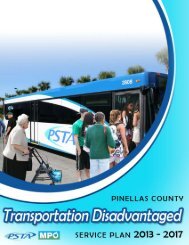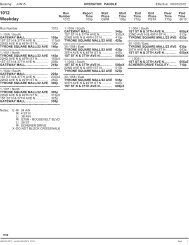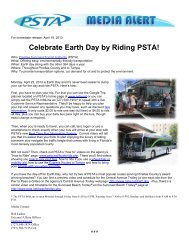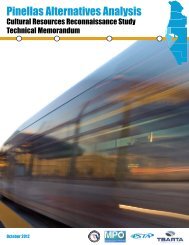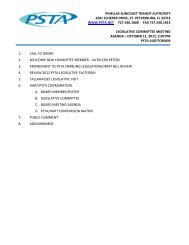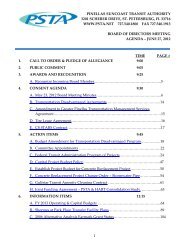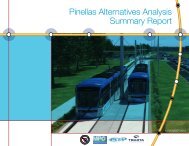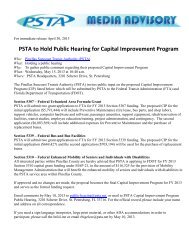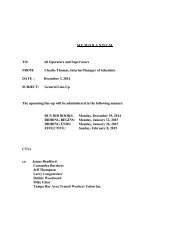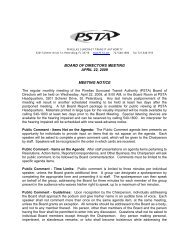DRAFT
FY 2020 - PSTA
FY 2020 - PSTA
- No tags were found...
You also want an ePaper? Increase the reach of your titles
YUMPU automatically turns print PDFs into web optimized ePapers that Google loves.
Implications – PSTA should prioritize the service improvements identified through publicinvolvement activities. Implementing more frequent service, more weekend service, later service,and more passenger shelters are PSTA priorities. However, service expansion will require a morestable and robust revenue source.TechnologyPSTA is making an effort to implement state-of-the-art technology and enhance the ability of customers toaccess transit information. PSTA is in the process of purchasing and installing a new Automated VehicleLocator (AVL) and real-time bus arrival systems. This upgraded technology allows customers to accesstransit information from hand-held devices and using dynamic message signs at key boarding locations.Additionally, PSTA has purchased a new camera system for the fleet in order to enhance safety forpassengers.In addition to implementing new technology,PSTA has made notable strides to “green”its transit fleet. In FY 2008, PSTA began aprogram of purchasing hybrid-electricvehicles. Compared with conventionalbuses, hybrid-electric buses consume lessfuel, have a longer brake life, and reduceemissions. The most recent purchase ofhybrid vehicles was completed using ARRAfunding. Fourteen new 35’ hybrid-electricvehicles were added to the PSTA fixedroutefleet in FY 2010. In addition to theARRA funding being used to purchase the new hybrid vehicles, PSTA will use FTA Section 5308 CleanFuels Grant funding and FTA Section 5308 Discretionary Bus and Bus Facilities program funding topurchase an additional eight hybrid vehicles to replace eight 1999 model fleet vehicles that are near theiruseful life.Finally, PSTA is proposing to purchase 48 “mini-hybrid” units to be installed on 48 conventional 2006-modelbuses with funds from the FTA TIGGER Grant Program. The mini-hybrid units are designed to optimizevehicle operating temperatures, maintain longer maintenance intervals, and reduce hydraulic oil, therebyimproving passenger safety and reducing engine overheating. The use of mini-hybrid systems is gainingmomentum in the transit industry as agencies strive for better mileage and generating lower emission levelsusing these types of units, particularly on older clean diesel vehicles.Tindale-Oliver & Associates, IncPinellas Suncoast Transit AuthoritySeptember 2010 6-13 Transit Development Plan




